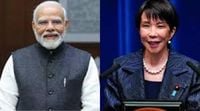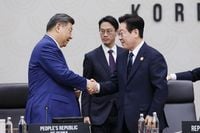As the Asia-Pacific region faces mounting economic and security challenges, leaders from across the globe gathered in Gyeongju, South Korea, for the 2025 Asia-Pacific Economic Cooperation (APEC) summit. The event, which concluded on November 1, brought together heads of state and government from 21 member economies, all eager to chart a path forward in a world marked by rapid technological change, shifting alliances, and persistent geopolitical tensions.
One of the summit’s most notable moments came as Canada’s Prime Minister Mark Carney met with Japan’s newly appointed Prime Minister Sanae Takaichi on the sidelines of the gathering. According to a statement released by Carney’s office and reported by multiple news agencies, the two leaders discussed ways to "expand the productive economic relationship between Canada and Japan, building on $32 billion in annual two-way bilateral merchandise trade." The meeting underscored the growing importance of bilateral ties in an era where global supply chains and economic interdependence are under increasing scrutiny.
Prime Minister Carney’s engagement with Takaichi was just one of several high-profile diplomatic exchanges involving the Japanese leader during her first days in office. On October 30, Indian Prime Minister Narendra Modi held his first telephone conversation with Takaichi, marking the beginning of what both sides hope will be a new chapter in the India–Japan Special Strategic and Global Partnership. As detailed by Capital FM, both leaders stressed that a stronger relationship between the two Indo-Pacific democracies is essential for global peace, stability, and prosperity.
During the call, Takaichi emphasized the importance of working together in the Indo-Pacific, including through the Quad framework—a strategic dialogue that also includes the United States and Australia. This conversation took place amid uncertainty over the timing of the Quad’s next summit, which has become a focal point for regional security cooperation. The two leaders also agreed to maintain close coordination on regional security challenges, reflecting growing concerns about the shifting balance of power in Asia.
Prime Minister Modi, in a post on X (formerly Twitter), described the exchange as a "warm conversation" and congratulated Takaichi on assuming office. He highlighted that the two sides discussed cooperation on economic security, defense, and talent mobility, with both agreeing that closer India–Japan ties would bolster regional and global stability. The timing of the call was significant, following Takaichi’s meeting in Tokyo with US President Donald Trump on October 29, further signaling Japan’s intent to reinforce its ties with key partners in the region.
Against this backdrop of bilateral diplomacy, the APEC summit itself produced a joint declaration that set a broad vision for the region’s economic future. As reported by GMA Integrated News, the 21 member economies vowed to push for "market-driven economic integration in the Asia-Pacific region," with a particular focus on advancing the Free Trade Area of the Asia-Pacific (FTAAP) agenda. The leaders committed to enhancing experience sharing, capacity building, business engagement, and technical cooperation among members—steps seen as vital for strengthening the region’s readiness to participate in high-standard, comprehensive regional undertakings.
Yet, the summit’s final communiqué did not shy away from acknowledging the significant headwinds facing the Asia-Pacific. The joint statement highlighted that "the global trading system continues to face significant challenges," with the rapid advancement of transformative technologies such as artificial intelligence and demographic shifts reshaping labor markets. The leaders called for "strengthened cooperation and concrete actions to enable economic growth that benefits all," reaffirming the belief that robust trade and investment are crucial for the region’s prosperity.
"We acknowledge the importance of a trade and investment environment that promotes resilience and benefits for all," the declaration read. The members also recognized the need for ongoing cooperation to navigate the evolving global environment, noting the "various discussions on the current state and future of global trade."
While economic integration and trade dominated much of the discourse, security concerns were never far from the surface—especially in light of ongoing tensions on the Korean Peninsula. South Korean President Lee Jae Myung, speaking at the summit’s closing ceremony, made a pointed appeal for peace and stability. As reported by Yonhap and IANS, Lee stated that Seoul would "continue taking preemptive measures to ease military tension and build trust with North Korea to promote peace on the Korean Peninsula."
Lee did not mince words about the stakes involved. "Military confrontation, tension, and nuclear issues have constrained stability and cooperation not only on the Korean Peninsula but across the entire Asia-Pacific region," he said. He pledged that South Korea would pursue even more proactive steps to advance peace, calling on APEC members for their support. "Peace on the Korean Peninsula is an essential condition for the prosperity of the Asia-Pacific region," Lee asserted, adding that "the path toward peaceful coexistence...can be realized with the support and cooperation of all APEC members."
In a symbolic moment at the end of the summit, Lee formally handed over the APEC chairmanship to Chinese President Xi Jinping, whose country will host the 2026 summit in Shenzhen. This transition comes at a time when US-China relations remain a defining factor for the region. Notably, the summit wrapped up shortly after President Donald Trump and President Xi agreed on a temporary truce in their ongoing trade war, generating a palpable sense of relief among many attendees and observers worldwide.
Throughout the summit, the interplay between economic ambition and security anxiety was evident. The region stands at what leaders repeatedly described as a "pivotal juncture," with choices made now likely to shape the trajectory of the Asia-Pacific for years, if not decades, to come. The emphasis on market-driven integration, technological adaptation, and inclusive growth underscored a collective recognition that the old rules of engagement are being rewritten in real time.
For Prime Minister Sanae Takaichi, her whirlwind debut on the international stage has set the tone for Japan’s diplomatic posture in the months ahead. Her outreach to leaders in Canada, India, and the United States signals a clear intent to strengthen Japan’s alliances and partnerships, even as she navigates the complex web of regional and global expectations. For leaders like Mark Carney and Narendra Modi, the summit offered a crucial opportunity to recalibrate strategies and reaffirm commitments in an uncertain world.
As the Asia-Pacific region looks ahead to 2026 and beyond, the outcomes of this year’s APEC summit—both in terms of concrete agreements and the broader spirit of cooperation—will serve as a touchstone for future efforts to build a more resilient, prosperous, and peaceful community of nations.

